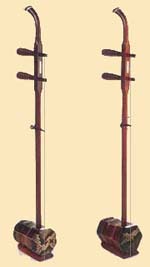
Erhu (two-stringed Chinese fiddle), also called Huqin, was known as Xiqin during the Song Dynasty (960-1279). Huqin described in the Yuan Dynasty (1271-1368) records was the real forerunner of the modern Erhu, having its stem, sound box and pegs made of wood. From the Qing Dynasty (1644-1911), more than ten kinds of Huqin came into being, including Erhu, Zhonghu, Sihu (four-stringed), Gaohu, Jinghu, Zhuihu and so on. All these musical instruments play an important role in national orchestras.

The sound box of Erhu can be round, hexagonal or octagonal, with one of its ends covered with snakeskin, sometimes from a python, and other end an ornamentally carved sound vent. There are two strings, played with a bamboo bow with horsetail hairs passing behind the strings. The range is normally five octaves, and sometimes four in special cases. In modern times, many people have made innovations to improve the tone color of Erhu.
The most widespread piece of Erhu music in China is Two Springs Reflect the Moon, composed by the Wuxi folk artist Ah Bing in the mid-20 century. This work has two themes, which complement and intertwine, and finally melt into each other subtly and smoothly. Step by step and variation upon variation, the two themes rise and fall effortlessly. The crescendos especially show the composer's steely and unyielding spirit. There is a profound range of feeling in this piece, which incorporates a majestic spirit within a tightly knit composition. Vigorous variations in bowing technique make full use of the five hand positions, and the result is a fiercely emotional coloring expressing of the composer's suppressed grief at having tasted to the full the bitterness of life in the old society. Two Springs Reflect the Moon is an exquisite example of Chinese instrumental folk music stemming from the heart of a small-town folk artist.
The leading Erhu innovator of modern times is Liu Tianhua, who composed 10 excellent pieces of music for Erhu. His maiden work, Groaning in Illness, also called Anshi or Hushi, portrays the mental world of China's progressive intellectuals on the eve of the May 4th Movement of 1919, when they were sunk in gloom and despair; their spirit of resistance seemed to be up against insuperable obstacles. Moonlit Night is another fine piece by Liu, which was written to express his emotions as he enjoyed the coolness of a moonlit summer night, and his heart was stirred as he gazed at the moon riding high in the sky. The composition was finalized six years after this experience. The melody, pure and understated, unfolds softly and pleasingly. Ode to Dejection, also known as Joy in Bitterness, is a direct exposition of Liu's thoughts and feelings at a time when he was ambitious to make contributions to Chinese music, but was struggling in adverse circumstance. This piece represents the disappointment of intellectuals at that time, who were wandering lost and could see no gleam of hope for the future. His Song of Sadness, also known In Difficulties, uses the scattered clapper rhythm, and also successfully adapts elements of Western music and applies a skillful bowing technique. The theme of Song of Staying Idle is the short-lived happiness of moments when things are going smoothly. The melody is lingering, and rich in variations. The composer used overtones for the first time, to extend the power of expression of the instrument and broaden the range of the tune. The Candle Flickers Red was the swan song created by Liu in his short life. It is built on variations, and the oscillations are fairly well pronounced. Its sprightly tune expresses a mood of happiness, being enriched by dance rhythm.





















